They need to keep up appearances - and promote their brand. "Now it’s a ‘theme park."
Published Sep 10, 2024 • 9 minute read
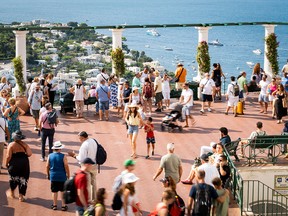
POSITANO, Italy – Ivan Stefanovic set up his tripod in the middle of the sidewalk, parting the crowd that had gathered to admire the sweeping cliffside views of the Amalfi Coast. After pressing record on his phone, he twirled and dipped his partner, who teetered in chunky-heeled sandals as her dark, wavy hair cascaded toward the ground. She laughed, and he whispered some pointers in her ear – strut more, wobble less.
Advertisement 2
THIS CONTENT IS RESERVED FOR SUBSCRIBERS ONLY
Subscribe now to read the latest news in your city and across Canada.
- Unlimited online access to articles from across Canada with one account.
- Get exclusive access to the Vancouver Sun ePaper, an electronic replica of the print edition that you can share, download and comment on.
- Enjoy insights and behind-the-scenes analysis from our award-winning journalists.
- Support local journalists and the next generation of journalists.
- Daily puzzles including the New York Times Crossword.
SUBSCRIBE TO UNLOCK MORE ARTICLES
Subscribe now to read the latest news in your city and across Canada.
- Unlimited online access to articles from across Canada with one account.
- Get exclusive access to the Vancouver Sun ePaper, an electronic replica of the print edition that you can share, download and comment on.
- Enjoy insights and behind-the-scenes analysis from our award-winning journalists.
- Support local journalists and the next generation of journalists.
- Daily puzzles including the New York Times Crossword.
REGISTER / SIGN IN TO UNLOCK MORE ARTICLES
Create an account or sign in to continue with your reading experience.
- Access articles from across Canada with one account.
- Share your thoughts and join the conversation in the comments.
- Enjoy additional articles per month.
- Get email updates from your favourite authors.
Sign In or Create an Account
or
Article content
When the digital nomad posted scenes of his trip on Instagram, his followers would see a stylish gadabout soaking up the natural beauty in one of Italy’s most-admired vistas.
What they wouldn’t glimpse was the ugliness outside the frame: The long queue at the Via Cristoforo Colombo overlook, where selfie-takers posed with their arms high in the air and their backs to the pedestrians struggling to get around the hordes. The endless parade of buses, cars and Vespas rumbling past, blowing plumes of exhaust. The dismayed expressions of residents who watched overtourism devour their beloved villages.
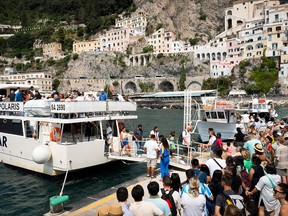
“Social media has a lot to answer for,” said Lara Capraro, a Positano local whose late father ran a tour boat operation. “People treat the Amalfi Coast like a theme park. I don’t know how much longer it can go on like this.”
The causes of overtourism are complex, but affected destinations can point to at least one overriding factor. Santorini, Greece, has a crush of cruise ships; Dubrovnik, Croatia, attracts rabid “Game of Throne” fans. The Amalfi Coast suffers from overexposure on social media. Search “Amalfi Coast” on TikTok, and you will be bombarded with serene videos of pastel-colored villages wedged into the cliffside like Jenga pieces.
Advertisement 3
Article content
“It’s a mixed bag,” said Mikaela Howell, a Philadelphia-based wedding photographer who was scouting out locations with her videographer husband. “It’s fun to have all the energy of people being here, but everyone wanting to see the same thing makes it a little less magical.”
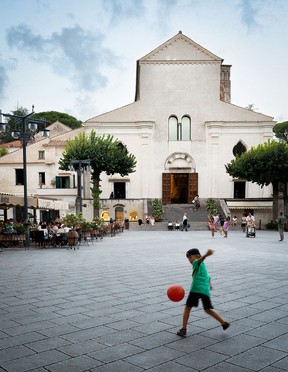
Even Stefanovic, who says he mines TikTok and Instagram for inspiration, started to wilt in the heat and crowds. “It’s getting hot,” Stefanovic said, as he paused the shoot to take refuge under a patterned black umbrella.
To prepare for my four-day trip to this scenic stretch of the Campania region, I consumed a steady diet of TikTok videos and Instagram posts. It didn’t take long to discover that the paradise depicted on social media omitted a trove of unpleasant details.
The Amalfi you don’t see on TikTok
The 34-mile-long Amalfi Coast, a UNESCO World Heritage site, is pinned between the Lattari Mountains and the Tyrrhenian Sea, an arrangement that is easy on the eyes but tough on urban planners. To attain la dolce vita, you need to climb countless steep steps in punishing heat.
The region can be difficult to access, which few influencers will tell you. (One memorable exception: Lexi Jordan, who slammed her compatriots for not providing “disclaimers.”) Most travellers fly into Naples and catch a train or ferry to the southern coast. Because of the impossible traffic and limited parking, renting a car is not recommended. The fashionable people cruising around in vintage Fiats are not showing us the harrowing crawl along SS163 or their futile attempts at finding a parking spot.
By signing up you consent to receive the above newsletter from Postmedia Network Inc.
Article content
Advertisement 4
Article content
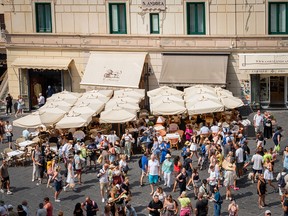
No influencers warned me that the ferries often sell out by early morning and that the only other reasonable option is the public bus. (Hiring a private boat was not my world.) After I huffed and puffed up a hill and several flights of stairs to the station in Sorrento, I spent an hour waiting for a bus to Positano. On the return, a coach crammed with passengers flew by our group waiting at a bus stop on the side of a dark road. The next one had more space. For nearly an hour, the children in the back sang Miley Cyrus songs at the top of their lungs.
“Influencers just show the good parts, but they don’t know about the transportation problems or how it’s not possible for us to rent a house because they’re all Airbnbs,” said Francesca Grammatico, a 20-year-old student who works at her family’s cafe, Il Panino, in Ravello. “I think in 30, 40 years, it’s going to be a tourist town. People my age just want to leave, because the quality of life is not very good.”
In Amalfi, I stepped around bodies splayed on the steps of the Roman Catholic cathedral and was nearly swept away by a mob trying to board a bus to Ravello. I had more room to move at Villa Cimbrone, a garden with the much-liked Terrace of Infinity.
Advertisement 5
Article content
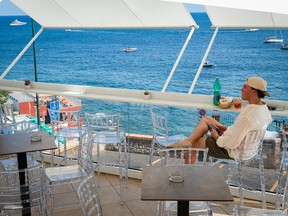
Every influencer feed I watched featured a selfie on the Spiaggia Grande in Positano, but the beach attendants asked me to leave: once, because I was not a resident; the second time, because I had not paid 40 euros to enter the private strand.
At Le Sirenuse, a Positano hotel adored by influencers and celebrities such as Kylie Jenner, who celebrated her birthday there in 2019, a stern man in a trim suit informed me that the hotel was closed to the public till 6 p.m. Next door, Franco’s Bar opened at the same hour, though people dressed for an evening of cocktailing were already queuing up.
I took a detour from my itinerary and stopped at Hotel Marincanto, where the waitstaff was racing around the patio bar preparing for the sunset crowd. After downing a $10 glass of lemon water, I returned to Franco’s. The line had fully subsumed the sidewalk.
Italian officials envision the Salerno Costa d’Amalfi Airport as one possible salvation. The facility – which has operated as a military airport, flying school, private airport, and firefighter and parachuter training centre – reopened to commercial air in July, more than a dozen years after the last scheduled flight landed here.
Advertisement 6
Article content
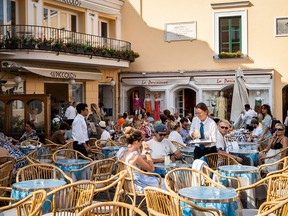
Tourism and transportation authorities hope the revived airport will alleviate the pressure on the international airport in Naples, which handled nearly 12.4 million travellers last year, and disperse people to less congested parts of the Campania region. The intended effect is to extend the region’s season, which typically runs from April through October.
“Salerno, which is very popular among Italians, is not popular abroad,” said Margherita Chiaramonte, the commercial director of aviation at the Naples and Salerno airports for GESAC, the airports management company. “But it really deserves to be, because it has stunning, unspoiled villages and well-preserved traditional places.”
However, tourism experts and locals say the officials are deluding themselves. People will still flock to the Amalfi Coast. An unfamiliar destination with no social media bona fides is a tougher sell.
“We need to have that thing that everyone else has,” said Jonathon Day, a sustainable tourism expert and associate professor in Purdue’s School of Hospitality and Tourism Management, “or it’s like we’ve lost out.”
Advertisement 7
Article content
Traffic jams and no parking spots
For many influencers who make content as a career, chasing down followers and sponsorships takes precedent over painting a nuanced picture of a destination. They need to keep up appearances – and promote their brand – even at the expense of a destination’s quality of life.
“They have this idea or opinion of the best places and why, and the people who follow them are going to say, ‘Oh, I’m going to go here because so-and-so told me that,’” said Marla Royne Stafford, a professor of marketing and international business at the University of Nevada at Las Vegas. “That makes them incredibly powerful.”
Day, the Purdue professor, doesn’t blame influencers for the chaos that overtourism has wrought. He faults government officials for being blindsided by the surge in visitors.
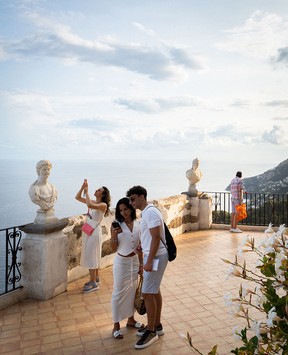
He said legislators should have proactively created a tourism management plan. Instead, they are scrambling to fix the problems with regulations that locals say aren’t working. For example, they introduced in 2019 an alternating license plate system for nonresidents that was supposed to tackle traffic and parking woes. Five years later, both issues are as bad as ever.
Advertisement 8
Article content
During a lull in serving visitors panini and lemony drinks in Ravello, Grammatico described her commute to school. She said the drive to the town of Amalfi typically takes 15 minutes in the offseason – but hours during peak months.
“I usually get out of school at 1 p.m. but won’t get home till 3 p.m.,” she said. She can’t wait to leave for medical school in Rome this fall.
Many locals do not use their cars during the tourist invasion for fear of never finding a parking spot. On foot, they avoid the crowded main pedestrian routes and follow a secret passageway through back alleys.
On a Saturday afternoon, Capraro sat on her patio near the Spiaggia Grande, the beach strip where hundreds of bodies were browning under the broiling sun. Tourists stopped by to ask for directions – “Really, up those stairs?” they would gulp.
Demanding and impatient tourists
Tourism is an economic dynamo in Italy, which U.N. Tourism ranked as the fifth most-visited destination by international travelers last year.
The sector poured about $238 billion into Italy’s coffers, according to the World Travel and Tourism Council, which translates to nearly 11 percent of the nation’s gross domestic product. This year’s forecast is even higher.
Advertisement 9
Article content
The Amalfi Coast has been a longtime magnet for travelers and creative types, including film stars, writers and artists seeking a muse or an Aperol spritz by the sea. The sharp rise in mass tourism is more recent.
The number of visitors started ticking upward a few years before the coronavirus pandemic and boomed after the global health crisis subsided. For the Amalfi Coast’s 13 villages, the Agenzia Regionale Campania Turismo registered 564,981 lodging check-ins in 2023, a 9 percent rise compared with 2019. A decade earlier, fewer than 400,000 people stayed here.
“Social media makes everyone feel like they can afford to visit Amalfi or Positano, and it has become super crowded,” said Debra Levinson, founder and chief executive of Mr. & Mrs. Italy, a tour operator. “They don’t necessarily need us, because their rooms fill up a year in advance or more.”
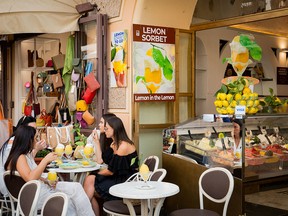
Levinson said the average daily rate on the Amalfi Coast has risen nearly 40 percent from pre-pandemic hotel prices, forcing budget travelers to spend beyond their means or find accommodations in less pricey cities and day trip to the coastal villages. She said that unless a client has a strong reason for visiting the area – say, their deceased mother once painted landscapes of the Amalfi Coast – then she will send them to alternatives such as the Italian Riviera, farther north on the Ligurian Sea, or Ischia, an island about 20 miles west of Naples.
Advertisement 10
Article content
“True luxury is being able to separate yourself from the masses of people,” Levinson said.
Shopkeepers in Amalfi and Capri complain about day-trippers much like the folks who lament the invasion cruisers to their shores. They, too, arrive en masse on ferries or buses, spend minimally and clog the streets monumentally, especially at photogenic sites on influencers’ lists.
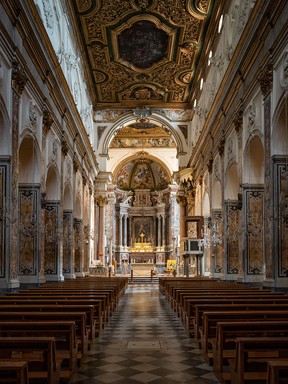
“Basically, people don’t spend money,” said Paola Savinelli, who runs an Italian street food restaurant in the town of Amalfi. “They take pictures of the Duomo, buy a gelato or the cheapest thing they can buy, and then go.”
At a neighboring pottery store, a couple pawed through bins filled with four-euro souvenirs. They snapped a photo of themselves with ceramic plates decorated in lemons and left empty-handed.
“Before covid, it was calmer and the quality of people was better. They were more respectful,” Grammatico said. “They are demanding and impatient now.”
At a public bathroom in Ravello, an attendant’s smile was mostly greeted with grimaces or no expression at all. Anna, who collects the 1 euro bathroom fee and checks the supplies, said summer is “a mess of tourists.” Though the region relies on tourism dollars, that arrangement doesn’t mean she has to like her benefactors. “Sometimes they are rude,” she said in Italian, “but that’s life.”
Capraro said social media has unleashed a new wave of visitors who are younger and rowdier than their predecessors. They stay in Positano after the last ferries have departed – and party deep into the night.
She often waits till midnight to feed the cats who live on the beach. The boisterous tourists scare the strays, who hide until it’s safe to come out.
Article content
.png)
 1 week ago
12
1 week ago
12








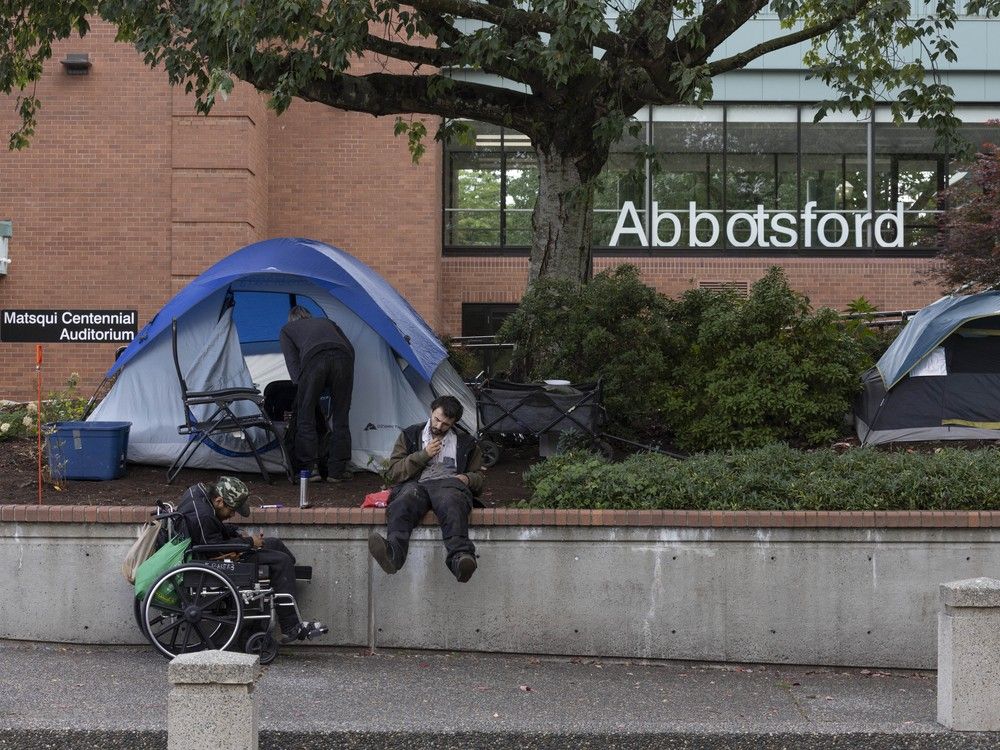
























 Bengali (BD) ·
Bengali (BD) ·  English (US) ·
English (US) ·